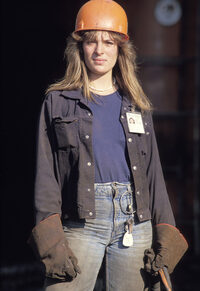 According to a recent data analysis from health and safety consultants Arinite, between the years of 2009 and 2014 male workers were more than 20 times as likely as females to suffer a fatality whilst at work.
According to a recent data analysis from health and safety consultants Arinite, between the years of 2009 and 2014 male workers were more than 20 times as likely as females to suffer a fatality whilst at work.
In 2013/14 alone, 85 male workers died on the job compared to just four women. Of those 89 deaths, 42 were related to the construction industry. The most common cause of these workplace fatalities was falls from height.
Male workers were also almost as twice as likely to suffer a major or minor work-related injury than their female counterparts. You can see the exact year on year figures on this health and safety data tracker.
So why the gender gap?
Despite pushes from organisations such as The National Association of Women in Construction (NAWIC), the number of women actively working in this risk-heavy industry is still remarkably low, at just 13.4% as of 2014.
This phenomenon, known as occupational segregation, where jobs are skewed in favour of a specific gender, goes some way to explaining the gender divide. Health and safety consultant Bryan Richards proposes that “proportionally more men carry out more hazardous work activities. Although there has been an on-going debate for more equality in women doing ‘men's’ work, it does not work out in practice.”
Construction worker Daniel Long suggests that rather than the physical side being a deterring factor for women, it’s the social side which could have the biggest impact:
“Construction sites are not always particularly ‘women-friendly’, because of the attitude of the people there. I don’t know many guys on site who would mind watching a woman lift big blocks and not want to act macho and help her out. She’d struggle getting respect.”
There are, however, various jobs within the construction industry which do not necessarily require large amounts of heavy lifting, such as plastering, roofing, plumbing and so on.
We must also consider the fact that major and minor accidents are also almost twice as likely to involve men, regardless of whether they occur on a construction site or in a crammed office. The most common cause of this is slips, trips and falls. Perhaps the construction industry alone cannot account for the sheer proportion of men dying whilst at work.
Office worker Luke Rees suggests another reason for the gap between gender fatalities. He believes that it may relate to the stigma surrounding what constitutes a ‘man’s job’, where female colleagues expect men to carry out risk-intensive activities. Rees says, “People often say ‘I need some strong, young lads’ when they want something done that involves risk. Even if it’s something simple such as changing a lightbulb, it’s still often expected that men will be the ones that get up there to do it. This means we’re constantly getting exposed to more workplace hazards – falling from stepladders and those kinds of things – than women.”
So what steps need to be taken to ensure that workplace deaths and accidents are kept to a minimum?
Richards says: “The main reason for fatal accidents is a lack of appreciation of the hazards of falling. This is because of complacency (e.g. in not wearing fall arrest equipment because they have never fallen before), ignorance (e.g. fragile roofing), lack of training (e.g. young persons not trained in safe techniques), lack of protective measures (e.g. guard rails, netting, etc).”
“When it comes to falls and trips, it would be difficult to eliminate this most common cause of injury at work, but injuries can be avoided or reduced by controlling the common factors that may cause trips and falls. These include: the working environment (office, factory), the type of floor surface (slippery, non-slip), contamination (spillages), obstacles (trailing cables, boxes etc.), footwear (non-slip, high heels), and people (mobility, disability, distracted when walking etc.). Employers need to make sure these health and safety risks are covered if they want to promote an injury-free workplace.”
Do you feel safe in your workplace? Do you think you’re expected to do ‘men’s work’ in the place of women? Let us know in the comments!